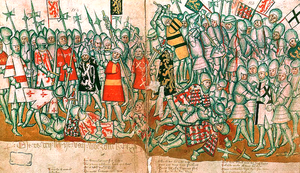
The Duchy of Guelders is a historical duchy, previously county, of the Holy Roman Empire, located in the Low Countries.
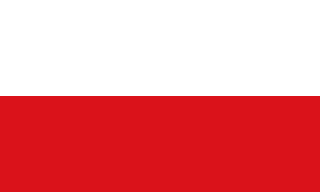
Berg was a state—originally a county, later a duchy—in the Rhineland of Germany. Its capital was Düsseldorf. It existed as a distinct political entity from the early 12th to the 19th centuries.

The County of Mark was a county and state of the Holy Roman Empire in the Lower Rhenish–Westphalian Circle. It lay on both sides of the Ruhr River along the Volme and Lenne rivers.
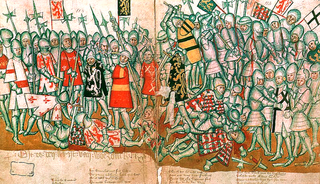
The Battle of Worringen was fought on 5 June 1288 near the town of Worringen, which is now the northernmost borough of Cologne. It was the decisive battle of the War of the Limburg Succession, fought for the possession of the Duchy of Limburg between on one side the Archbishop Siegfried II of Cologne and Count Henry VI of Luxembourg, and on the other side, Duke John I of Brabant.

The Duchy of Limburg or Limbourg was an imperial estate of the Holy Roman Empire. Much of the area of the duchy is today located within Liège Province of Belgium, with a small portion in the municipality of Voeren, an exclave of the neighbouring Limburg Province. Its chief town was Limbourg-sur-Vesdre, in today's Liège Province.
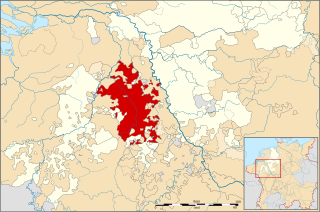
The Duchy of Jülich comprised a state within the Holy Roman Empire from the 11th to the 18th centuries. The duchy lay west of the Rhine river and was bordered by the Electorate of Cologne to the east and the Duchy of Limburg to the west. It had territories on both sides of the river Rur, around its capital Jülich – the former Roman Iuliacum – in the lower Rhineland. The duchy amalgamated with the County of Berg beyond the Rhine in 1423, and from then on also became known as Jülich-Berg. Later it became part of the United Duchies of Jülich-Cleves-Berg.

Burg Castle, located in Burg an der Wupper (Solingen), is the largest reconstructed castle in North Rhine-Westphalia, Germany and a popular tourist attraction. Its early history is closely connected to the rise of the Duchy of Berg.
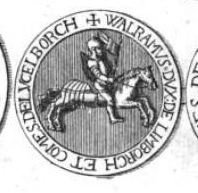
Waleran III was initially lord of Montjoie, then count of Luxembourg from 1214. He became count of Arlon and duke of Limburg on his father's death in 1221. He was the son of Henry III of Limburg and Sophia of Saarbrücken.

Waleran IV was the duke of Limburg from 1247 to his death. He was the son and successor of Henry IV and Ermengarde, countess of Berg.

Henry IV was the duke of Limburg and count of Berg from 1226 to his death. He was the son of Waleran III, count of Luxembourg and duke of Limburg, and Cunigunda, daughter of Frederick I, Duke of Lorraine.

SiegfriedII of Westerburg was Archbishop of Cologne from 1275 to 1297.
Henry of Berg, Lord of Windeck was the son of Adolf VII of Berg and Margaret of Hochstaden. He was the younger brother of Adolf VIII of Berg and William I of Berg.
Adolf VIII of Berg was the eldest son of Count Adolf VII of Berg and Margaret of Hochstaden.

Reginald I of Guelders was Count of Guelders from January 10, 1271 until his death. He was the son of Otto II, Count of Guelders and Philippe of Dammartin.
Ermengarde was the ruling suo jure Duchess of Limburg from 1279 to 1283. She was the daughter of Judith of Kleve and Waleran IV, Duke of Limburg. She was named after her paternal grandmother.

The War of the Brabantian Succession was a war of succession triggered by the death of John III, Duke of Brabant. He had no sons, and as the Duchy of Brabant had a tradition of male (agnatic) primogeniture, his three daughters and their three husbands, namely the dukes of Luxemburg and Guelders and the count of Flanders, claimed the inheritance.

The house of Limburg Hohenlimburg took its name in the 12th century from the county of Limburg on the river Lenne in today's Germany. After Diederick of Isenberg had claimed part of the former property of his father Frederik of Isenberg with the help of uncle Duke Hendrik of Limburg, he built the Hohenlimburg castle on the river Lenne. His youngest son Everhart succeeded him in the county at the end of the 13th century and is the ancestor of the family branch of the counts of Limburg Hohenlimburg and Broich. His eldest brother Johan (1247-1277), died at the age of thirty, left three children. The Counts of Limburg Hohenlimburg and Broich were not only a count by name (title), but actually ruled the county of Limburg-Lenne until the first quarter of the 16th century. The last count Johan (1464-1511) who had no descendants of his own. None of his only two male relatives, cousins Diederick and Adolf of Limburg, sons of his former godfather Johan of Limburg (1421-1472), had inheritance rights, as explained below. To prevent the family of his former wife Von Neuenahr from taking the county, Count Johan adopted his cousin Irmgard of Sayn at her marriage to Winrich of Daun. She and her husband inherited the county.
